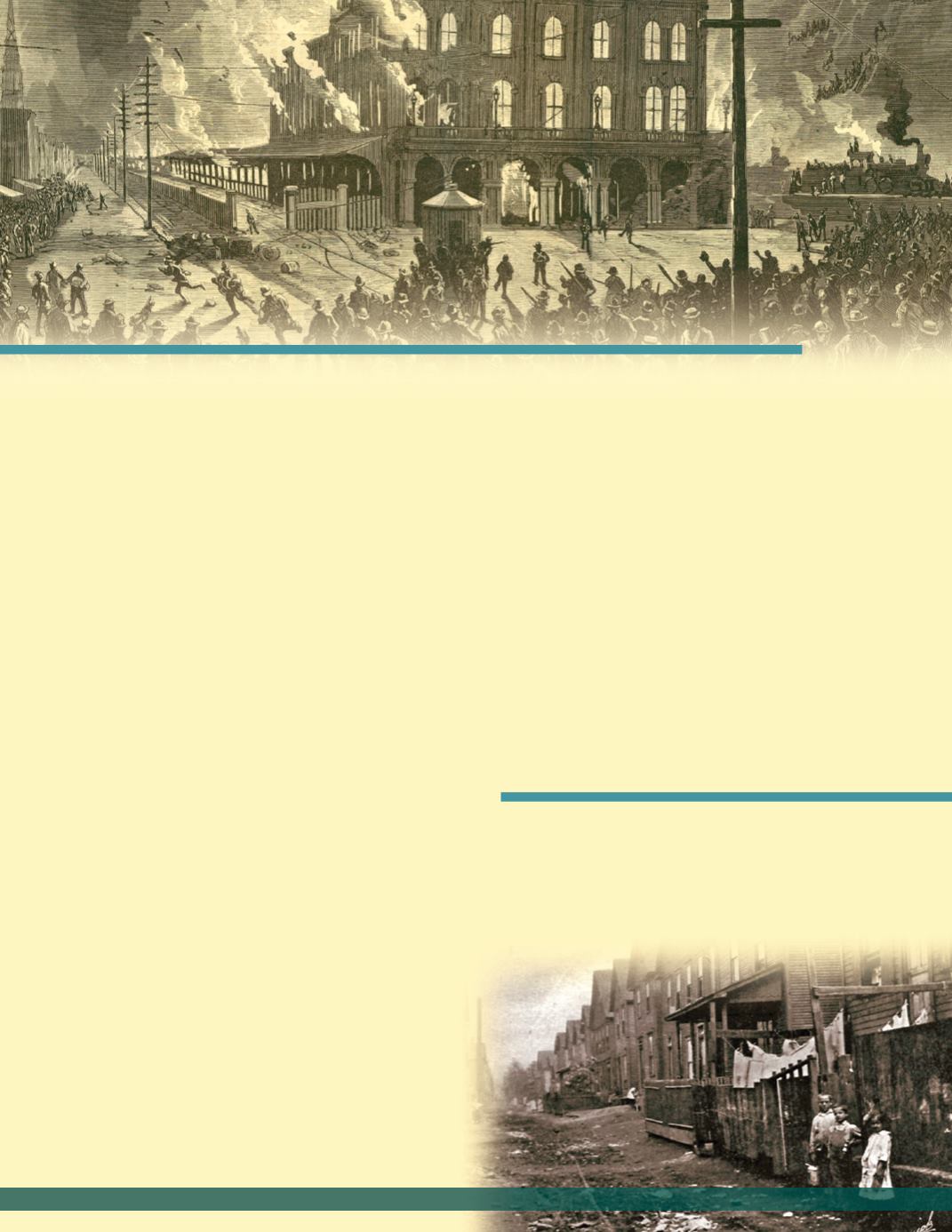
Workers tried to improve their working conditions
by organizing groups called
unions
. Unions could
provide greater ability to negotiate with the factory
andmine owners for improving wages and working
conditions. If the owners did not agree with the
demands of the union, the workers sometimes went
on
strike
. This is when workers refuse to work until
their demands aremet. One protesting worker can
easily be replaced, but it ismuchmore difficult to
replace your entire work force.
There weremany bitter strikes between workers
and owners of railroads, mines, and factories. In 1877,
a violent national strike known as the
Great Railroad
Strike
spread throughout our state. Rail yards at
Philadelphia
,
Reading
, and
Shamokin
were affected by
the violence. Pittsburgh was the site of the worst
violence. When fighting broke out in a rail yard between
workers and statemilitia troops, 24 people were killed,
126 locomotives were destroyed, 2,000 railroad cars
were wrecked, andmany buildings were burned.
Unionsmade workers stronger, but not without
cost. In 1892,
Homestead
(near Pittsburgh) was the
location of another violent strike against steel factory
owners
AndrewCarnegie
and
Henry Clay Frick
. When
strikebreakers were brought in to the factories, violence
erupted. Many people on both sides were killed or
wounded, and the conflict dragged on for months.
Problem2: The Growth of Cities and
Their Impact on the Environment
The growing industries of steel, railroad, and coal
meant more jobs in Pennsylvania. People poured into
our cities and towns from threemajor sources. Some
migrated fromour state’s rural areas. Others came
fromother parts of our country. Andmany were
immigrants
who travelled here fromother parts of the
world, mainly Europe. These people were eager to
work andmost settled in our growing cities where the
jobs were. By 1880, one in every seven people who
lived in Pennsylvania had been born in Europe.
By 1900, Philadelphia’s population had grown to
nearly threemillion, fromonemillion just 40 years
earlier. No other state except New York hadmore
immigrants. Thousands of African-Americans from the
South alsomoved to our cities following the Civil War.
They moved for the same reason that the Europeans
moved—to find jobs.
The Industrial Revolution had a severe effect upon
Pennsylvania’s environment. During this era, towns and
cities did not have planning committees to handle the
rapid growth. Consequently, dirty and wretched living
conditions erupted, which led tomany problems. Filthy
smoke belched from factory chimneys, leading to poor
air quality and also breathing problems for our citizens.
Factories also dumped their waste products into
streams and rivers. Human sewage was “flushed” into
the water supply. These same waterways were used to
supply homes with drinking, cooking, and washing water.
Water quality became very poor, leading to poor hygiene
and the spread of disease, such as cholera and typhoid.
This illustration depicts some of the violence that occurred in Pittsburgh during the Great Railroad Strike of
1877. After amonth of constant rioting, President Rutherford B.Hayes sent in Federal troops to end the strikes.
Industrial Growth CreatesMajor Problems
95
Immigrants and other workers in Pennsylvania’s new industrial
towns endured terrible living conditions. The same companies
that employed these workers also owned the housing and stores in
these towns, and charged higher-than-average prices to their
captivemarket. Little attentionwas paid to the environment in
these towns, with factory smoke polluting the air and other waste
polluting the rivers, streams, and water supply.


